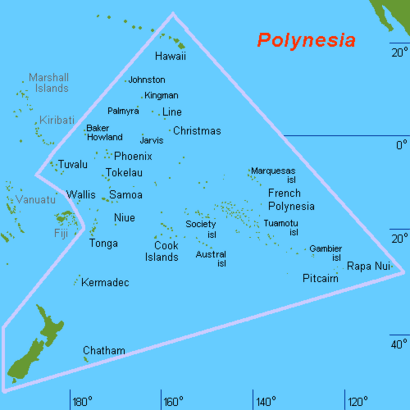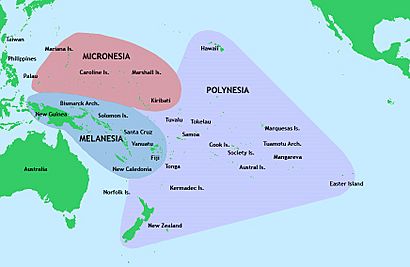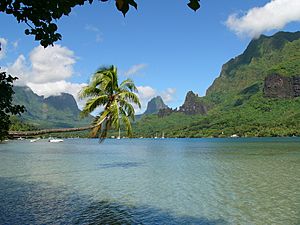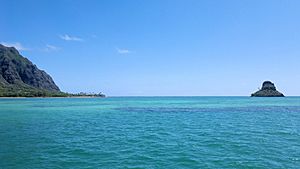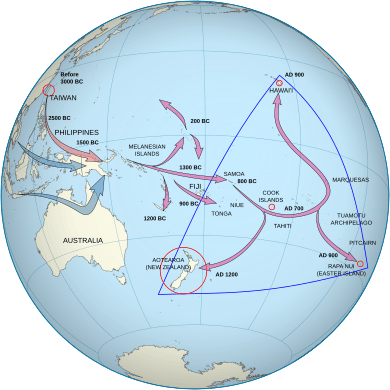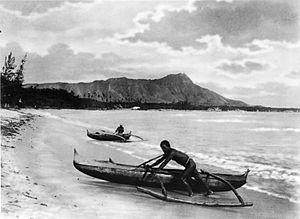Polynesia facts for kids
Polynesia is a large area in Oceania with over 1,000 islands spread across the central and southern Pacific Ocean. The name "Polynesia" comes from Greek words meaning "many islands."
The people who live on these islands are called Polynesians. They share many things, like their languages, culture, and beliefs. Long ago, they were amazing sailors who used the stars to find their way at night. The biggest country in Polynesia is New Zealand.
A French writer named Charles de Brosses first used the word "Polynesia" in 1756. At first, it meant all the islands in the Pacific. Later, in 1831, a man named Jules Dumont d'Urville suggested it should only refer to a smaller group of islands. The Hawaiian Islands are part of Polynesia, even though they are in the North Pacific. The area often called the Polynesian Triangle includes Hawaii, New Zealand, and Easter Island.
Contents
Geography of Polynesia
How the Islands Were Formed
Polynesia has a small amount of land spread over a huge part of the Pacific Ocean. Most Polynesian islands, like the Hawaiian Islands and Samoa, are volcanoes that grew from "hotspots" deep in the Earth.
New Zealand, Norfolk Island, and Ouvéa are different. They are parts of a mostly sunken continent called Zealandia. This continent is thought to have sunk 23 million years ago. It recently rose again because of how the Earth's plates moved.
New Zealand has the oldest rocks in the region, about 510 million years old. Outside of Zealandia, the oldest Polynesian rocks are in the Hawaiian Emperor Seamount Chain, which are 80 million years old.
The Polynesian Triangle
Polynesia is usually defined by the islands inside the Polynesian Triangle. This triangle connects Hawaii (in the north), New Zealand (in the southwest), and Easter Island (in the southeast).
Other important island groups inside this triangle include Samoa, Tonga, the Cook Islands, Tuvalu, Tokelau, Niue, Wallis and Futuna, and French Polynesia.
Some Polynesian people also live outside this main triangle. You can find small Polynesian communities in places like Papua New Guinea, the Solomon Islands, and Vanuatu. Rotuma, an island north of Fiji, also has strong Polynesian culture.
Polynesia is mainly a cultural term. It is one of the three main cultural areas of Oceania, along with Micronesia and Melanesia.
Main Island Groups
Here are some of the main islands and island groups that are part of Polynesian culture:
- American Samoa: A territory of the United States.
- Cook Islands: A self-governing state linked with New Zealand.
- Easter Island: A special territory of Chile.
- French Polynesia: An overseas country of France.
- Hawaii: A state of the United States.
- New Zealand: An independent country.
- Niue: A self-governing state linked with New Zealand.
- Norfolk Island: A territory of Australia.
- Pitcairn Islands: A territory of the United Kingdom.
- Samoa: An independent country.
- Tokelau: A territory of New Zealand.
- Tonga: An independent country.
- Tuvalu: An independent country.
- Wallis and Futuna: A territory of France.
- Rotuma: A dependency of Fiji.
Some islands like the Kermadec Islands and Auckland Islands had Polynesian people long ago but were empty when Europeans arrived.
Polynesian Outliers
Polynesian people also settled islands outside the main triangle. These are called "outliers."
- In Melanesia: Islands like Anuta, Bellona Island, Fiji, Mele, Nuguria, Nukumanu, Ontong Java, Rennell, Sikaiana, Takuu, and Tikopia.
- In Micronesia: Islands like Kapingamarangi and Nukuoro.
- In the Subantarctic islands: The Auckland Islands show the southernmost signs of Polynesian settlement.
History of the Polynesian People
Where Polynesians Came From
Polynesian people are part of the larger group called Austronesian peoples. These people were great sea travelers. Their journey started in Taiwan, then moved through Island Southeast Asia and Island Melanesia.
Around 3000 to 1000 BCE, people speaking Austronesian languages began to spread from Taiwan.
One main idea, called the "Express Train model," suggests that people moved quickly from Taiwan, through the Philippines and Indonesia, and reached western Polynesian islands around 900 BCE. This idea is supported by many studies of genes, languages, and old artifacts.
Around 1400 BCE, a group known as "Lapita Peoples" appeared in the Bismarck Archipelago. They were known for their special pottery. They adapted to new foods like breadfruit as they traveled.
Studies show that the first people to settle in places like Vanuatu and Tonga came directly from Taiwan or the northern Philippines. Later, they mixed with people from New Guinea and the Solomon Islands, which is why modern Polynesians have a mix of Asian and Papuan ancestry.
The Lapita culture spread quickly, reaching Fiji, Tonga, and Samoa around 3,000 years ago. Over time, the cultures of Fiji and the distinct Polynesian cultures of Tonga and Samoa grew apart.
Polynesian Culture
When Polynesians first arrived in Fiji, Tonga, and Samoa, their societies were focused on the mother's side of the family. Women had a very important role. Even today, studies of DNA show that Polynesian women's ancestors came from Asia, while men's ancestors came from New Guinea and nearby islands. This fits with the idea that women stayed in their home areas.
Over time, these family structures changed, but Polynesians still valued women highly in their traditions. The special Lapita pottery also disappeared in Western Polynesia. By the time people settled Eastern Polynesia, their language, social life, and tools were very uniquely "Polynesian."
The exact dates for settling Eastern Polynesia (like Hawai'i, Easter Island, and New Zealand) are still debated. Some studies suggest it happened in two quick periods between 1025 and 1290 AD. Easter Island might have been settled around 1200 AD. Other ideas suggest earlier dates, like 300-500 AD for Easter Island and 500 AD for Hawaii.
Political History
Tonga
In the 16th century, after a civil war, the Tu'i Kanokupolu family gained power in Tonga. In 1845, a young leader named Tāufaʻāhau united Tonga into a kingdom. He became King George Tupou I in 1875 and made Tonga a constitutional monarchy. This meant he shared power and gave people rights like freedom of the press.
Tonga became a British-protected state in 1900 but kept its own monarchy. It gained full independence on June 4, 1970.
Samoa
Samoa has a long history of ruling families, including the Tui Manu'a and Malietoa. In 1899, Samoa was divided between Germany and the United States. The German part was taken over by New Zealand during World War I. Samoa became independent on January 1, 1962. It is no longer a monarchy, but the Malietoa title-holder was very important until 2007.
New Zealand Māori
On October 28, 1835, some Māori tribes declared their independence to protect themselves from French colonization. The British recognized this in 1836.
However, in 1840, the United Kingdom took over New Zealand, using the Treaty of Waitangi. In response, Māori tribes tried to form their own monarchy to unite against the British. Pōtatau Te Wherowhero became the first Māori king in 1858.
Over time, all tribes came under the colonial government. Māori culture and language were suppressed. But starting in the late 1950s, efforts were made to save and promote the Māori language (te reo Māori). Now, many people in New Zealand speak Māori.
Cook Islands
The Cook Islands are made up of 15 islands. The largest is Rarotonga, which is the capital. It is believed that the Cook Islands were settled in two main periods, first between 900 and 1300 AD, and then again around 1600 AD by people from Tahiti.
Cook Islanders are Polynesian and share strong cultural ties with Tahiti, Easter Island, New Zealand Māori, and Hawaii.
Tuvalu
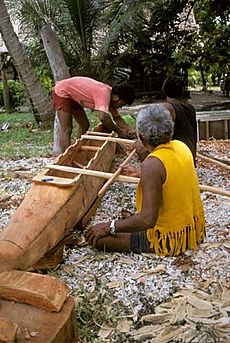
The islands of Tuvalu are part of West Polynesia. Long ago, Polynesians traveled between these islands using their amazing navigation skills. Eight of Tuvalu's nine islands were inhabited, which is why its name means "eight standing together."
People from Samoa and Tonga settled the Tuvaluan atolls. Tuvalu then became a stepping stone for Polynesians to move to other islands in Melanesia and Micronesia.
Fishing was a main food source. People also grew food on the low-lying islands. They had to manage their population because of droughts and the risk of famine from storms.
Links to the Americas
The sweet potato, called kūmara in Māori, comes from the Americas. It was already common in Polynesia when Europeans first arrived. Scientists think Polynesians might have traveled to South America and brought it back around 700 AD.
There are also ideas about other items like chickens and coconuts possibly traveling between Polynesia and the Americas before Columbus. However, these ideas are still debated by experts.
A famous idea by Thor Heyerdahl in the mid-20th century suggested Polynesians came from the Americas. He even sailed a raft called the Kon-Tiki to try and prove it. However, scientists have shown that his ideas were incorrect. Evidence from language, culture, genes, and archaeology proves that Polynesians came from Asia, not the Americas.
Polynesian Cultures
Polynesia has two main cultural groups: East Polynesia and West Polynesia.
West Polynesian cultures, found in places like Tonga, Niue, Samoa, and Tuvalu, are used to larger populations. They have strong traditions for marriage, laws, money, and trade.
East Polynesian cultures are found on smaller islands and atolls, like the Cook Islands, Tahiti, Hawaii, and Easter Island. The large islands of New Zealand were settled by East Polynesians who adapted their culture to a cooler climate.
Unlike Melanesia, Polynesian leaders were often chosen based on their family line. However, Samoa had a system called Fa'amatai that combined family background with real-world skills to choose leaders.
Skills like religion, farming, fishing, weather prediction, and building outrigger canoes were very important. The survival of an entire island depended on them. Trading was also key. Navigators were highly respected. Each island often had a special house for navigation and canoe building.
Polynesian settlements were either small groups of houses (hamlets) or larger villages. Hamlets were usually on bigger volcanic islands where food was plentiful. Villages were built on the coasts of smaller islands, often with walls for protection.
Polynesians were also amazing artists and craftspeople. Even simple things like fish-hooks were made with great care and decorated. Stone and wooden weapons were seen as more powerful if they were well-made and decorated. Weaving was also a very important art form.
The religious beliefs of Polynesians were similar across the Pacific. They shared stories about how the earth and sky were created and about the gods. People would travel thousands of miles to join in shared celebrations.
Starting in the 1820s, many missionaries came to the islands and converted many groups to Christianity. Today, Polynesia is one of the most Christian regions in the world. Christianity was quickly adopted into Polynesian culture, and things like war and slavery became less common.
Polynesian Languages
Polynesian languages are all part of the Oceanic languages family, which comes from the larger Austronesian languages family. These languages are quite similar to each other.
They generally use the same vowels: a, e, i, o, and u, pronounced like in Italian or Spanish. Consonants are always followed by a vowel. The languages change slightly from island group to island group. For example, r and v are used in central and eastern Polynesia, while l and v are used in western Polynesia.
The word for the ancestral homeland, *sawaiki, changes in different languages:
- In the Society Islands, it's Havai'i.
- In New Zealand, it's Hawaiki.
- In the Cook Islands, it's ‘Avaiki.
- In the Hawaiian islands, the largest island is named Hawai‘i.
- In Samoa, the largest island is called Savai'i.
Economy
Except for New Zealand, most independent Polynesian islands get a lot of their money from foreign aid and from relatives living and working in other countries who send money home. Some islands encourage young people to work abroad to earn money for their families.
Many Polynesian places, like Easter Island, also earn money from tourism. Some have unique ways to make money, like Tuvalu which sells its internet domain name '.tv', or the Cook Islands which used to rely on selling postage stamps.
Working Together in Polynesia
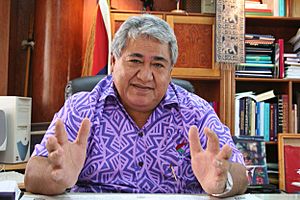
In 2011, three independent countries (Samoa, Tonga, and Tuvalu) and five self-governing territories started the Polynesian Leaders Group. They wanted to work together on things like culture, language, education, climate change, and trade. It's not a political union, but a way for Polynesian leaders to cooperate.
Polynesia covers a huge triangular area, with islands spread out over thousands of miles. Polynesians settled islands from Hawaii in the north, to Easter Island in the east, and New Zealand in the south.
Navigators traveled to these distant islands using only their senses and knowledge passed down through generations. They memorized important facts like:
- The movement of specific stars and where they would rise.
- Weather patterns.
- Travel times.
- Wildlife (like birds that gather near islands).
- The direction of ocean swells and how they felt in the canoe.
- The colors of the sea and sky, especially how clouds formed over islands.
- Angles for approaching harbors.
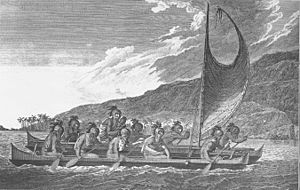

These wayfinding skills and how to build outrigger canoes were kept secret within special groups called guilds. Navigators were highly respected. If there was a famine, they could trade for help or move people to other islands.
When Captain Cook explored the Pacific, he had a Polynesian navigator named Tupaia. Tupaia drew a map of 130 islands and knew how to sail to many of them, even those far away.
Sadly, much of this traditional navigation knowledge was lost after Europeans arrived. However, in the 1960s, scholars began to test these old sailing methods. They learned from Micronesian navigators, like Mau Piailug, who still used traditional stellar navigation.
Scientists believe Polynesian navigators used many techniques. These included using stars, ocean currents, wave patterns, bird flights, winds, and weather. They might have even carried frigatebirds, which fly towards land when released. They also likely used wave and swell patterns to find their way.
The people of the Marshall Islands used special "stick charts" to show islands and wave patterns. These maps were simple but took years to learn how to use.
Images for kids
-
The three major cultural areas in the Pacific Ocean: Melanesia, Micronesia, and Polynesia
-
A depiction of a royal heiau (Hawaiian temple) at Kealakekua Bay, around 1816
See also
 In Spanish: Polinesia para niños
In Spanish: Polinesia para niños


